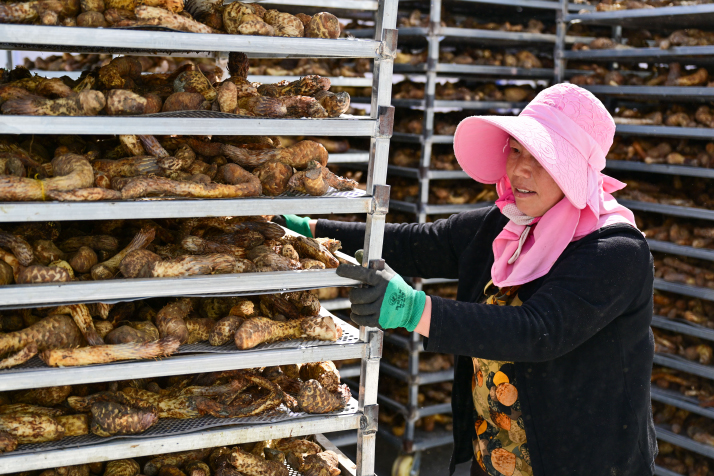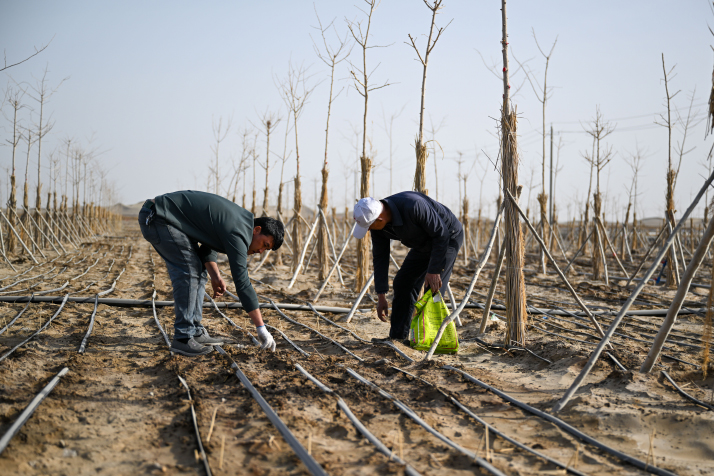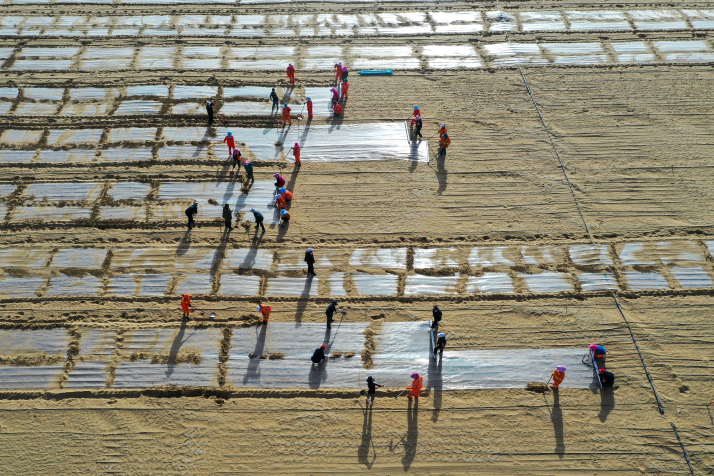| Xinjiang Today |
| Desert's destiny rewritten | |
|
|
 A sightseeing boat in the Huludao Scenic Area in Kuerle (Korla), where the Taklimakan Desert's dunes, tranquil lakes and poplar trees create a striking natural contrast, on October 25, 2024 (XINHUA)
A 2.2-km stretch of brick-paved road snakes through the wilderness of Ruoqiang County in Xinjiang. It stands as an enduring monument to the determination of road builders who decades ago conquered the harsh desert to construct a vital transportation artery.
Forming part of National Highway G218—which spans Xinjiang from Huoerguosi (Khorgas or Horgos) to Ruoqiang while skirting the fringes of China's vast Taklimakan Desert, this brick section has been intentionally conserved as a testament to the engineering history, though most of the highway has been upgraded to asphalt-paved road. Ruoqiang, the highway's terminus, is China's largest county by land area, 11 times Beijing's size. Situated on the southeastern edge of the Taklimakan, this region was long deemed uninhabitable. Now, Ruoqiang and its neighboring desert-front counties Hetian (Hotan), Qiemo and Shaya stand as proof of humanity's triumph on this unforgiving terrain.  Workers sort and sun-dry organic desert ginseng—cistanche—at a cultivation base in Qiemo County on April 9 (XINHUA)
The sand warriors Xinjiang contains some of China's largest deserts, which cover approximately 40 percent of the region's territory. The most formidable is the Taklimakan in south Xinjiang's Tarim Basin—the world's second largest shifting sand desert and China's largest. "The Taklimakan, a massive mobile desert, historically recorded dune expansions exceeding 100 meters in a single year, creating extreme management difficulties," Chen Yaning, a researcher at the Xinjiang Institute of Ecology and Geography under the Chinese Academy of Sciences, told Xinjiang Daily. "Its combination of hyper-arid conditions, persistent high winds and fine-grained sand capable of infiltrating any barrier makes containment uniquely challenging." For generations, Xinjiang's residents battled this advancing desert. Then in 1978, a large-scale counteroffensive began with the launch of the Three-North Shelterbelt Program—a massive afforestation initiative to combat desertification across north China's most vulnerable areas. Various communities have waged a 16,000-day (and counting) war against the sand on the Taklimakan's frontline. Through decades of perseverance, they've developed innovative solutions to green the deserts. Straw checkerboards—grids of dried straws and reeds pressed into dunes—have revolutionized desert stabilization. "We pioneered these structures, hailed as 'Chinese magic squares,' to anchor the shifting sand," Jia Lei, Deputy Director of the Forestry and Grassland Bureau of Minfeng County, Hetian Prefecture, told Guangming Daily. "In each grid, we plant drought-resistant species like the red willow and saxaul. When the straw decomposes after three to five years, the saplings' roots are anchored deeply enough to survive independently." By the end of 2023, 2,761 km of green sand-blocking barriers had been established along the Taklimakan Desert's 3,046-km periphery. The remaining 285-km gap—primarily wind corridors and outlets, and major sand migration paths—faces extreme water scarcity, making it the most sandstorm-battered and challenging zone in southern Xinjiang. Qiemo, a three-hour drive from Ruoqiang, is among China's most sandstorm-ravaged areas. Over 38 percent of the county is covered by desert, with the county seat just 2 km from the desert edge. "Twenty years ago, every sandstorm plunged us from daylight into darkness," said Kurban Rozi of Qiemo's Windbreak and Sand Control Station, Xinjiang's first county-level sand control station. His colleague, station director Abasi Aisa, voiced a dire warning, "Unless we halt the desert's advance, Qiemo will be swallowed up." History proves the veracity of this threat: The county's lifeline, the 813-km Qarqan River, had its course changed thrice due to desert encroachment and each time it was catastrophic for the county. When Qiemo's Windbreak and Sand Control Station was established in 1998, Kurban was among the seven pioneers working there. With just a few traditional Uygur curved-blade hoes used for digging and planting and watering cans, they worked relentlessly, with no certainty of success. Over 27 years, 1.5 million person-days of labor have transformed Qiemo's dunes. What began as experimental planting of the saxaul and desert poplar in barren sand has matured into vast, thriving shelter forests. On November 28, 2024, the Taklimakan Desert was finally encircled by a 3,046-km green barrier, the world's longest desert-edge defense system.  Drip irrigation in progress at the desert agriculture experimental base in Hetian on April 8 (XINHUA)
Green gold in the sand In the process of weaving green barriers to contain the desert, continuous experience-summarizing and technological innovation have yielded remarkable results. The "plant symbiosis" model developed in Xinjiang represents an innovative approach to combating desertification. This system strategically pairs two complementary plant species to achieve both ecological stabilization and economic benefits. The primary species are drought-resistant trees or shrubs like the saxaul, desert poplar, or plants from the tamarix family, which serve as anchors, stabilizing the moving sand. Due to their deep root systems, extending up to 10 meters underground, each plant can secure around 6,700 square meters of dunes while their canopies help reduce wind speed. The secondary component consists of valuable parasitic or understory plants such as the desert ginseng or dogbane, used to make medicines. These species provide economic returns without competing for scarce resources. Today, desert ginseng farming has expanded, supporting over 200,000 farmers. The annual output in Qiemo alone exceeds 6 million yuan ($840,000) annually. More advanced sand control technologies and equipment have been introduced, improving planting efficiency and water resource utilization. Last year, the Windbreak and Sand Control Station in Qiemo used intelligent robots to plant dogbane. "It was a national first," Abasi Aisa said. Enabled by AI, the robots dug, sowed and covered the saplings, increasing work efficiency.  Locals plant seeds of the coix, a maize-like cereal grain crop, at a desert agriculture experimental base in Hetian on April 8 (XINHUA)
The power of sand Photovoltaic desert control is the latest achievement in this decade in Xinjiang. In the 250,000-kilowatt photovoltaic industrial park in Shaya County, Aksu Prefecture, solar panels over two meters tall stand in orderly rows on the northern fringe of the Taklimakan. If you stand near the panels, you can distinctly feel the reduction in the wind speed. "The panels form solid barriers that lower ground-level wind speeds, reduce sand erosion and stabilize desert soil," Song Ye from Shaya's Forestry and Grassland Bureau told Xinhua News Agency. In the shade of the panels, 1-square-meter straw checkerboards interlock across the ground, firmly containing the billowing sand. Nearby, drought-resistant plants like the saxaul and red willow are meticulously cultivated, forming multi-layered vegetation that better fixes the sand and improves the soil. Song said Shaya has afforested 4,200 hectares of desert, with 80 percent of the saplings surviving, thanks to the solar projects. This vegetation also provides habitat and food for desert wildlife. "We use solar-powered pumps to extract groundwater for irrigation," Song explained. "Water-saving drip irrigation maximizes every drop's value, sustaining the surrounding vegetation." The brackish water from solar operations is desalinated and reused. Partnering with Zhejiang University, the county has established a sprawling pilot demonstration base to treat desalinated water so that it meets the freshwater standard for crop irrigation. The solar panels continuously convert the blazing sunlight into clean electricity, significantly reducing desert control costs. "The industrial park's 72 power units have a 250-megawatt total capacity, meeting the annual electricity demands of approximately 430,000 people," Song said. The revitalized landscape has catalyzed desert tourism. Nowhere is this more evident than in the Kumtag Desert in Shanshan County, the desert closest to a city in China, just a 20-minute walk from Shanshan. This desert's diverse dune formations have earned it the moniker of "natural museum of global desert landscapes." Designated a National Scenic Area in 2002 and included among China's Top 10 Most Beautiful Deserts in 2019, it attracts over 110,000 visitors annually. Desert sightseeing is integrated with scientific exploration, sand sports and sand therapy wellness to form a comprehensive ecotourism zone. "We've transformed the desert from an 'urban threat' into a 'harmonious tourism resource,'" Wen Jing, Director of the Kumtag Desert Scenic Area Administrative Committee in Shanshan, said at a forum last year. "Through desert adventures, stargazing camps and sand therapy experiences, we enable visitors to deeply appreciate the wisdom of human-sand coexistence." Comments to yuanyuan@cicgamericas.com |
|
||||||||||||||||||||||||||||
|